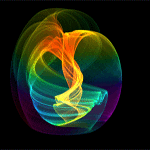Visualizing The Future

Visualizing the Future of Human Evolution
(FHE) is a series of articles that explore how humankind visually
sees and interprets the universe.
The series "looks" at how a wide range of visualization methods are used to interpret and understand the universe and ourselves. The spectrum of visualization methods ranges from primitive cave drawings to art, electron microscopy to telescopes, photography to movies, dreams to the paranormal, and optics to CGI used in scientific modeling and simulation.
How we visualize the universe spans across a wide spectrum of disciplines. The list ranges from media (movies, TV, CD/DVD, games, the Internet, virtual reality) to science (telescopes, microscopes, modeling, simulation, even astrology), to the arts (performance, paintings, drawings, sculpture), to our views in politics, religion, education and commerce.
Visualizing FHE surveys the various analog and digital hardware, software, methods and tools used by the various disciplines to produce images (and sounds). More importantly, the articles investigate how these various disciplines use images to interpret, understand, and ultimate persuade people to "see" a certain way.
Exploration into the visual includes how we see ourselves--looking inside our minds--and a look into the things we can't see (death, outerspace, the future).
Since antiquity, we've used a number of devices and techniques to visualize the future, from crystal balls and tarot cards to the latest virtual reality. Prophecy has played an important role in human development, in everything from anticipating "the coming of the Lord" to wartime strategies to predicting stock market swings.
Virtual reality, 3D modeling and other Internet technologies allow us to create virtual worlds and virtual communities. Through role playing, we can be someone other than ourselves, offering a decidedly different perspective other than our own.
Mindreading, parallel universes, and the paranormal are other ways we try and see that which we cannot see. These excursions into the world of seeing are not quite as mathematical as the modeling and simulation software used in such areas as military strategy, weather forecasting, space exploration, population analysis, ecological change or even chaos and complexity. But, they are no less important.
A number of themes run throughout the Visualizing FHE series. These themes intersect and diverge. These themes include storytelling in Hollywood, reality vs. fantasy, what we see and what we don't see, science and art, and optics in everyday life. These themes interweave in a kaleidoscope of color and light, influencing how we see ourselves and how we see our future.
An important note: Much of the historical and technical information in Visualization FHE is the result of online research. In some instances, information was extracted and then rewritten and/or edited. Nearly all the websites are authoritative websites of manufacturers, educational institutions and government organizations.
However, dates, in particular, do not always gel, as well as who invented what, when and where. Consequently, information is accurate, up to a point. The Visualizing FHE series is not meant to be the definitive source on the subjects covered. If there was a discrepancy in the dates, a phrase like "In the early 80s" or "In the late 17th century" were used instead.
The SIGGRAPH history of computer graphics doesn't reflect
all the subjects covered in Visualizing FHE, but
does cover most media events, computer developments and some
optics milestones in addition to computer graphics. It's an
inspirational timeline, nonetheless.
Please don't hesitate to send an email to the FHE webmaster if there's any suspect of misinformation. The series will be periodically reviewed for errors, deletions and additions. Please don't hesitate to send an email, period.
All the subjects covered in Visualizing FHE are complex enough to warrant their own libraries, if not entire universities dedicated to research on any given subject. So the series is very much just a review.
Otherwise, the rest of Visualization FHE is pure speculation. The ultimate purpose is to inspire new ways of visualizing the future of human evolution and discover-or re-discover-the maze of visualization tactics we use to communicate.
Profound credit is due to the numerous companies, organizations, websites, artists, technicians and writers, dedicated to finding new ways to help better see the world, the universe and ourselves.
^ Top ^


